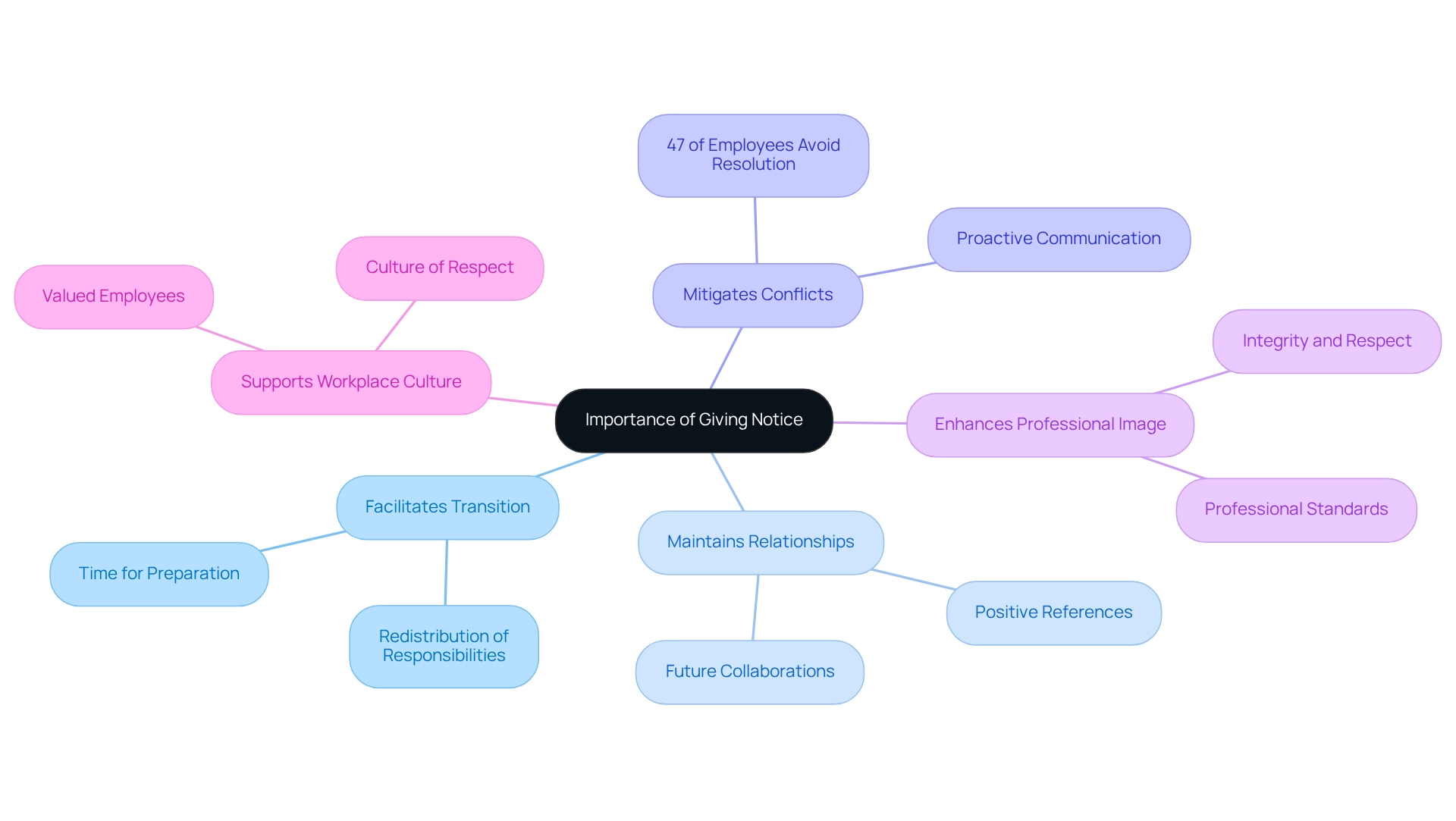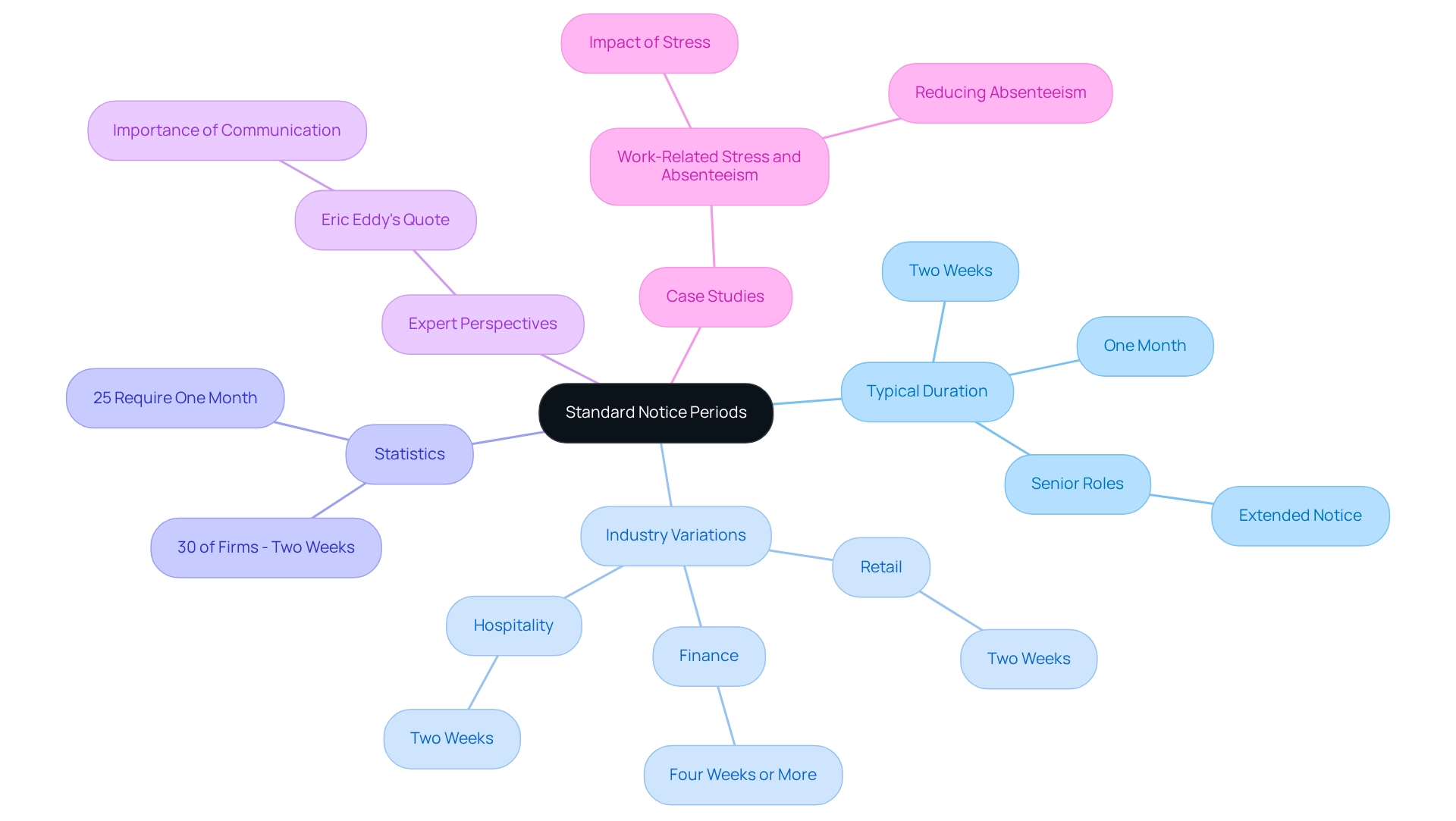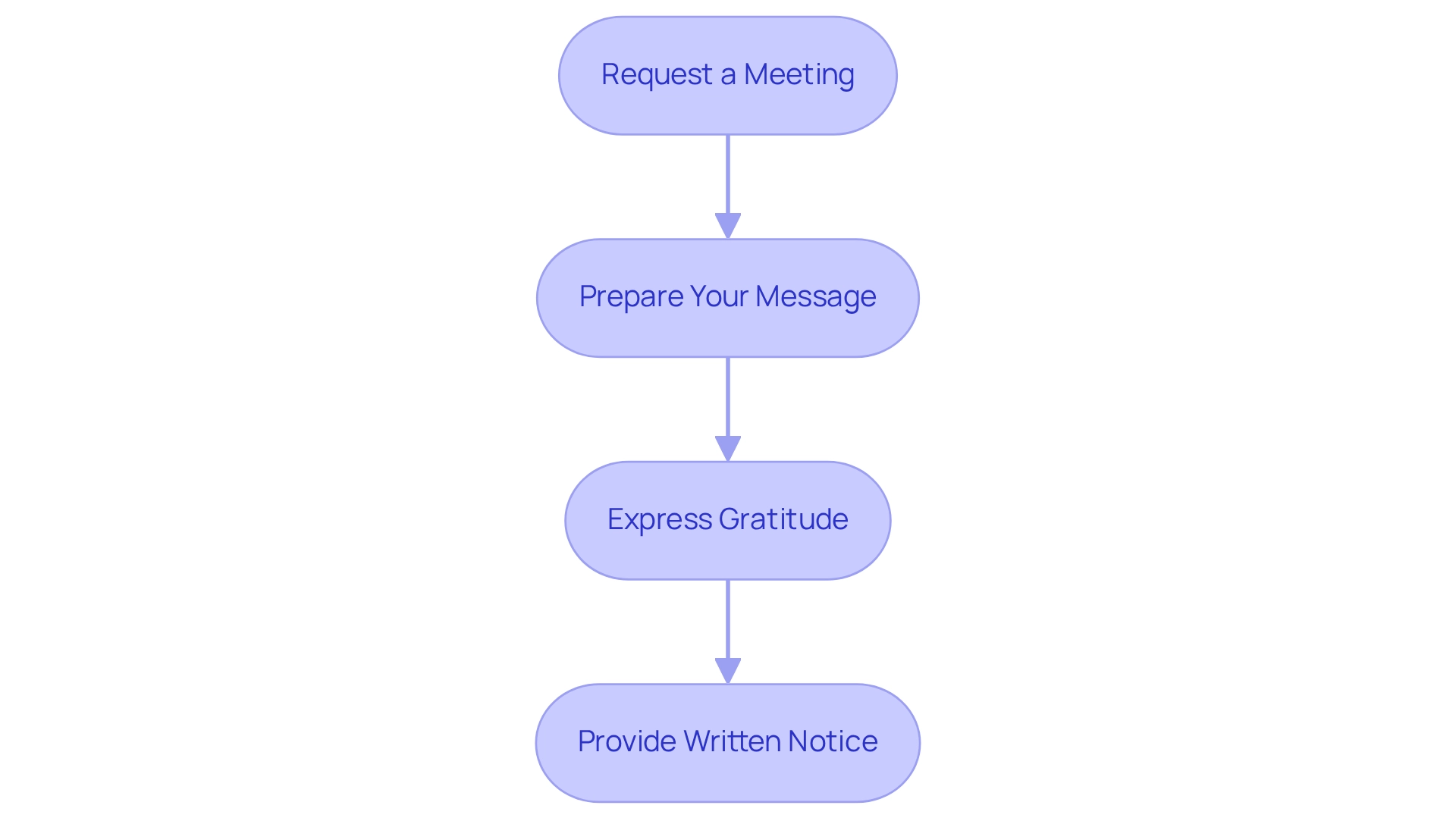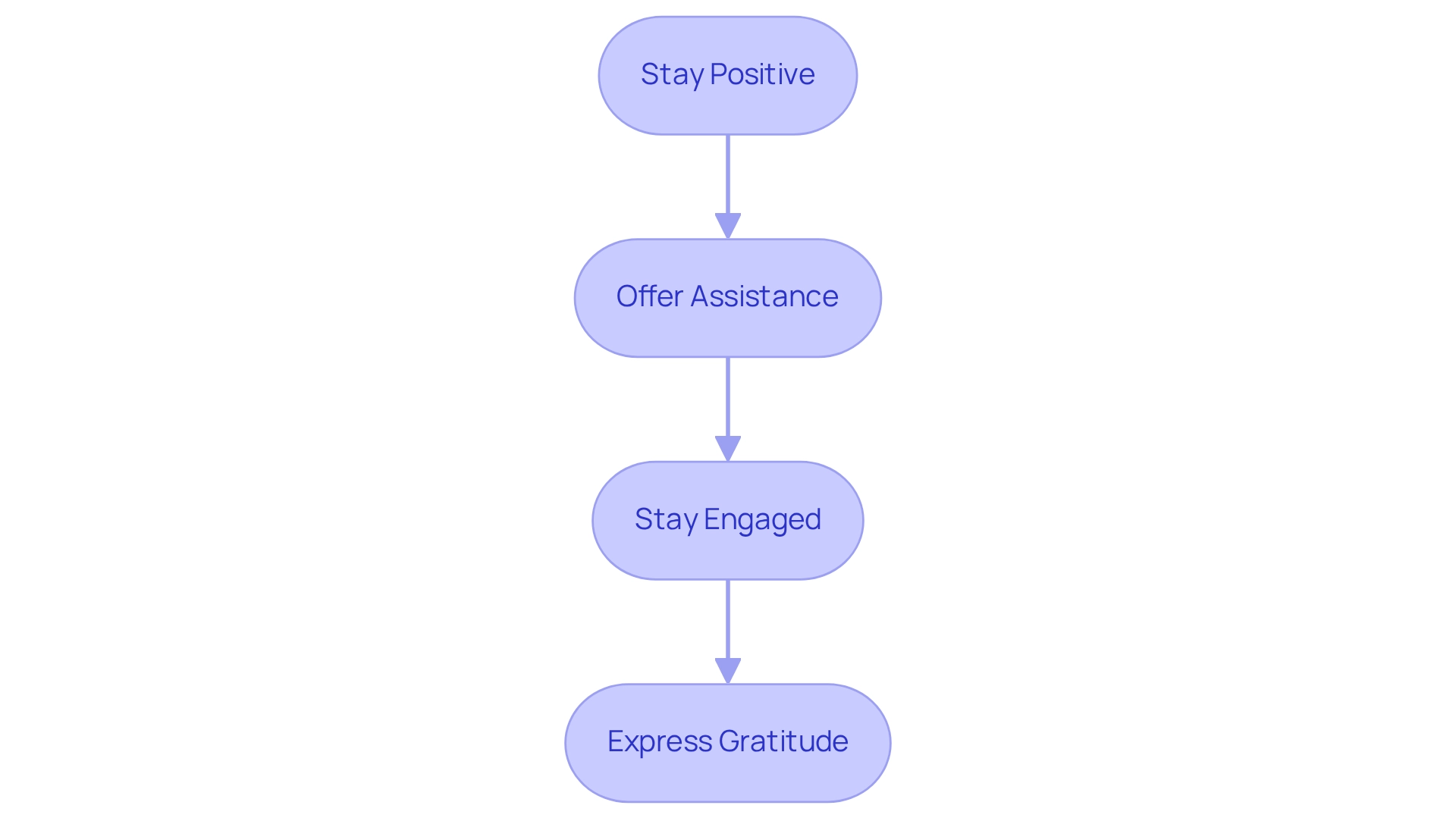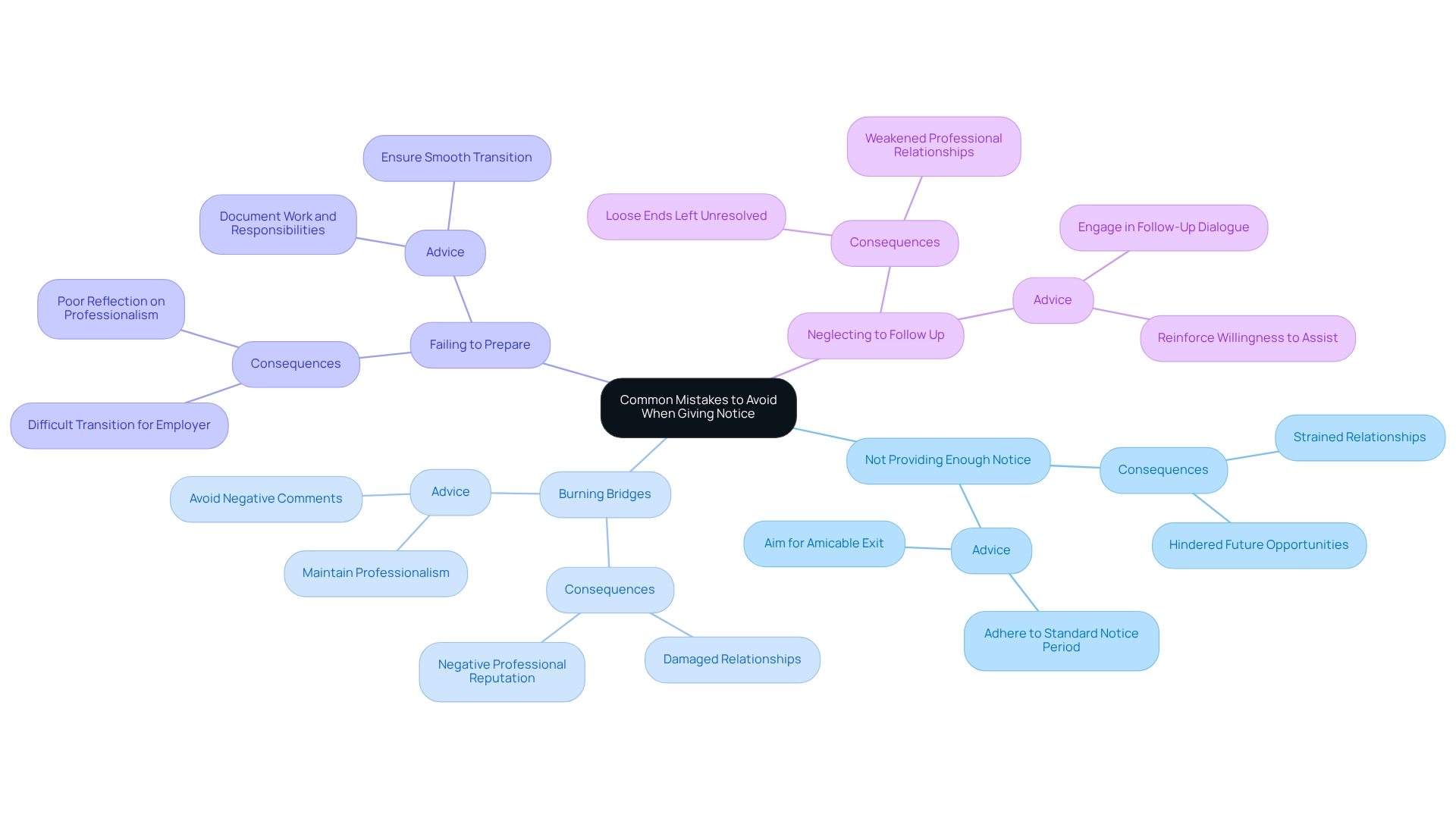Overview
The article serves as an authoritative guide on giving notice to an employer, highlighting the critical importance of professionalism and clear communication throughout the resignation process. It delineates essential steps, including:
- Understanding notice periods
- Preparing for the conversation
- Sustaining positive relationships
Each of these elements is vital for ensuring a smooth transition and preserving professional integrity, which is crucial for future opportunities.
Key Highlights:
- Giving notice is a professional courtesy that aids in a smooth transition for both employer and employee.
- 47% of employees facing workplace conflicts do not seek resolution, highlighting the need for clear communication.
- Providing notice reflects integrity and respect, fostering positive references and future collaborations.
- Typical notice periods vary by industry; two weeks is standard, while senior roles may require a month or more.
- Understanding company policies and role responsibilities is crucial for determining appropriate notice duration.
- Communicating notice professionally involves requesting a meeting, preparing a clear message, and expressing gratitude.
- Upon giving notice, employers may respond with acceptance, counteroffers, changes in responsibilities, or emotional reactions.
- Maintaining positive relationships during the notice period involves staying engaged, offering assistance, and expressing gratitude.
- Common mistakes when giving notice include not providing enough notice, burning bridges, failing to prepare, and neglecting follow-up.
- Transparent communication and adherence to notice protocols can enhance professional reputation and future job prospects.
Introduction
Navigating the complexities of resigning from a job entails more than a mere farewell; it represents an art form that intricately weaves professionalism with personal integrity. The act of giving notice transcends a simple procedural step; it stands as a cornerstone for cultivating positive relationships and ensuring a seamless transition for both the employee and employer.
As workplace dynamics continue to evolve, grasping the significance of notice periods, the subtleties of communication, and the ramifications of sustaining professional connections becomes imperative.
This article examines the essential facets of resigning gracefully, illuminating the importance of proper notice, the variables that determine its duration, and the common pitfalls to evade, while underscoring the lasting value of respect and professionalism in the workplace.
Understanding the Importance of Giving Notice
Giving notice to an employer is not merely a formality; it is an essential professional courtesy that facilitates a smoother transition for both the employer and the employee. By providing notice, you grant your employer the necessary time to prepare for your departure, which may involve redistributing your responsibilities or initiating the search for a replacement. This act of respect underscores your commitment to maintaining a positive relationship with your employer and colleagues—an aspect that is crucial for future references and networking opportunities.
Statistics reveal that a significant portion of employees—47%—who encounter workplace conflicts opt not to seek formal resolution, often resulting in strained relationships. This underscores the importance of clear communication and professional conduct during transitions. By giving notice, you mitigate potential conflicts and foster a more amicable separation, thereby enhancing your standing within the industry. The case study on workplace conflict resolution illustrates that many employees feel unsupported in addressing disputes, emphasizing the necessity for proactive communication, such as providing advance warning, to avert misunderstandings and sustain a positive work environment.
Moreover, the impact of giving notice extends beyond immediate logistics; it can significantly influence employee-employer relationships. When notice is given professionally, it reflects integrity and respect, leading to positive references and potential future collaborations.
Conversely, departing without notice can jeopardize connections and tarnish your professional image. Expert opinions highlight the significance of how we convey our departures. As Satya Nadella, CEO of Microsoft, remarked, the evolving workplace necessitates a broader definition of productivity that encompasses collaboration and well-being.
Providing notice aligns with these expectations, showcasing your professionalism and consideration for the workplace environment.
As we approach 2025, the importance of professional courtesy in resignations remains paramount. By giving notice, you not only uphold your own professional standards but also cultivate a culture of respect and accountability within your organization. This practice can lead to a more supportive workplace environment, where staff feel valued and respected, ultimately benefiting all participants.
Standard Notice Periods: What You Need to Know
In most sectors, the typical timeframe for giving notice to an employer is generally two weeks; however, this can vary significantly based on company policy, the employee’s position, and their duration of employment. For instance, senior roles often necessitate extended advance alerts, typically lasting a month or longer. It is crucial to consult your employment agreement or company manual to grasp the specific conditions that apply to your situation.
Notice durations can differ markedly across various industries. In the finance and legal sectors, for example, it is common to observe advance times of four weeks or more, reflecting the complexity and responsibilities associated with these positions. Conversely, in fields such as retail or hospitality, a two-week notice is more prevalent, allowing for quicker transitions.
Statistics reveal that approximately 30% of firms across diverse sectors adhere to a standard two-week notice, while 25% require one month, particularly for managerial and executive roles. This discrepancy underscores the importance of understanding industry standards and organizational expectations.
Expert perspectives suggest that notice periods should align with the nature of the role and the potential impact of the employee’s departure. HR professionals advocate for transparent communication regarding notice requirements during the hiring process to set clear expectations from the outset. As observed by Eric Eddy, the ability of a company to present exceptional candidates swiftly and effectively often hinges on robust communication, especially during transitional phases.
Case studies demonstrate that organizations with clearly defined notice period policies experience smoother transitions and fewer disruptions. For instance, a study on job-related stress highlighted that transparent communication about timeframes can alleviate anxiety for both staff and employers, ultimately fostering a healthier workplace environment. This is particularly relevant considering that stress is a significant factor contributing to nearly a million workers missing work each day, with job-related pressures exacerbating high absence levels.
By 2025, the landscape of notice timelines continues to evolve, with numerous organizations reassessing their policies to adapt to changing workforce dynamics. The recent increase in Total Private Real Average Hourly Earnings, which rose by $0.01 in February 2025, may influence how companies approach advance notifications, taking economic factors into account. Understanding these trends is vital for both employees giving notice and employers managing transitions effectively.
Moreover, the phenomenon of presenteeism, where employees attend work despite being unwell, can lead to increased absenteeism and negatively impact workplace productivity, further emphasizing the necessity for clear notification policies.
Factors Influencing Your Notice Period
Several factors can significantly influence the length of your notice period, including:
-
Company Policy: Many organizations establish specific guidelines regarding notice periods, which can vary widely. Grasping your organization’s policy is essential, as it establishes the benchmark for what is anticipated during your departure. Recent conversations among HR experts highlight the significance of clear company guidelines regarding giving notice to employer, which can greatly affect employee experiences during resignations. While prior warning is intuitively beneficial, its effectiveness in managing fatigue is not well-supported by empirical evidence, suggesting a need for further research in this area.
-
Role and Responsibilities: The characteristics of your position significantly influence the advance time required. Higher-level roles often necessitate a longer transition time to ensure that responsibilities are adequately handed over and that the organization can maintain continuity.
-
Length of Service: Employees with over two years of service usually have a two-month advance requirement. However, excessive dependence on tenure for notification calculations can lead to discriminatory outcomes for certain groups, highlighting the need for a more nuanced approach.
-
Current Projects: If you are involved in crucial projects, offering an extended lead time can be advantageous. This allows your employer to manage the transition effectively and ensures that your contributions are handed over smoothly, preserving professional relationships.
Understanding these factors is essential for navigating the resignation process, particularly when it comes to giving notice to employer. A case study titled ‘Understanding Termination Periods’ illustrates how following termination periods can foster respectful exits and maintain positive relationships with employers, ultimately benefiting future career opportunities. As Barry B Fisher observes, ‘A New & Improved Theory of Reasonable Notification for Wrongful Dismissal’ highlights the significance of reasonable notification in upholding professional integrity.
By considering these elements, you can approach your departure thoughtfully and professionally.
How to Communicate Your Notice Professionally
To communicate your notice professionally, adhere to the following steps:
- Request a Meeting: Arrange a private meeting with your supervisor to discuss your departure. This face-to-face interaction is crucial; studies indicate that 93% of communication is often misattributed to being nonverbal, highlighting the importance of personal engagement in sensitive discussions.
- Prepare Your Message: Clearly articulate your intention to resign and specify your last working day. Being direct yet respectful sets a professional tone for the conversation. Remember, 31% of workers have left a job within the first six months, underscoring the need for effective communication and engagement strategies during this transition.
- Express Gratitude: Thank your employer for the opportunities and experiences you’ve gained during your tenure. Research shows that almost half of employees would consider leaving if they do not receive recognition for their contributions, making it essential to acknowledge the positive aspects of your time at the company.
When an employee decides to leave, it is important to follow proper protocol by giving notice to the employer. Provide written notice following up the meeting with a formal letter of departure. This letter should reiterate your last working day and express appreciation for your time at the company. A well-crafted letter of departure not only serves as a record of your exit but also strengthens your professionalism. As Maddy Martin, SVP of Growth, states, “Through effective outreach initiatives, we understand how to communicate effectively with prospects to boost revenue,” which can be utilized in your communication during departure.
By following these steps, you can ensure that your departure is communicated effectively and respectfully, maintaining positive relationships and a professional reputation. Additionally, consider how effective communication and delegation during this process can lead to improved productivity and client management, as illustrated in the case study titled “Focusing on Core Business Functions.
What to Expect After Giving Your Notice
Upon giving notice to your employer, you may encounter a variety of responses from them, each reflecting their perspective on your departure:
-
Acceptance: Many employers will recognize your professionalism and may express gratitude for your contributions. They might offer assistance during your transition, ensuring a smooth handover of responsibilities. This is especially significant in a competitive talent environment where keeping skilled individuals is essential.
-
Counteroffers: If you are regarded as a valuable asset to the team, be ready for the possibility of a counteroffer. Employers often attempt to retain talented staff by proposing salary increases, enhanced benefits, or improved working conditions. Statistics indicate that around 50% of workers who resign receive counteroffers, highlighting the competitive nature of talent retention. In fact, 73.9% of highly skilled workers feel there are better or more opportunities outside of their organization, which underscores the challenges employers face in retaining top talent.
-
Changes in Responsibilities: As you prepare to leave, your workload may shift. Employers might ask you to assist in training your successor or to finalize ongoing projects. This transitional phase can be crucial for maintaining team productivity and morale, especially as organizations strive to create a positive environment that appreciates contributions from staff members.
-
Emotional Responses: It’s common to experience a mix of emotions, such as relief, sadness, or anxiety about the future. Acknowledging these feelings is important, and seeking support from colleagues or mentors can help you navigate this emotional landscape. Understanding the potential reactions can prepare you for the next steps in your career journey, especially when giving notice to your employer.
In the context of a talent war, organizations with a strong culture of open communication tend to handle resignations more positively, fostering an environment where individuals feel valued even as they transition out. Furthermore, the top five sectors with the worst retention rates in 2019—Arts, entertainment, and recreation (79.5%), Leisure and hospitality (79.0%), Accommodation and food services (78.9%), Construction (65.0%), and Professional and business services (63.5%)—demonstrate the larger context of turnover and retention challenges that employers encounter. Insights from the case study on manufacturing quit rates indicate that while quit rates rose during economic expansions, manufacturing quit rates remained comparatively lower, highlighting the stability of certain sectors in retaining employees.
This insight underscores the importance of maintaining professionalism throughout the process.
Maintaining Professional Relationships During Your Notice Period
To maintain professional relationships during your notice duration:
- Stay Positive: Cultivating a positive attitude is crucial. Avoid negative comments about the company or colleagues, as this can impact your reputation and future networking opportunities. Research indicates that disengaged managers can cost organizations between $77 billion to $96 billion annually, highlighting the importance of maintaining a constructive environment even when transitioning out. Boutique Recruiting’s track record of success and numerous satisfied clients underscore the value of fostering positive relationships during such transitions.
- Offer Assistance: Take the initiative to facilitate a smooth transition. This could involve training a replacement or ensuring that outstanding tasks are completed. Such actions not only demonstrate professionalism but also reinforce your commitment to the team’s success, fostering goodwill that can benefit you in the future.
- Stay Engaged: Continue to participate in team activities and maintain open lines of communication with colleagues. Engaging with your team during this period can help solidify relationships and leave a lasting positive impression. The Leader–Member Exchange (LME) Theory emphasizes that fostering positive interactions enhances workplace relationships, which can lead to superior performance and lower turnover intentions. High-quality exchanges, as suggested by the LME theory, result in employees feeling more valued and supported.
- Express Gratitude: Take the time to thank your coworkers and supervisors for their support and collaboration throughout your tenure. Acknowledging their contributions can strengthen your professional network and leave the door open for future opportunities. As Jeremy Pollack notes, confidentiality is vital in maintaining professionalism during transitions, which can further solidify your relationships.
Maintaining these relationships is not just about courtesy; it can significantly impact your career trajectory. Successful transitions often hinge on the strength of your professional network, making giving notice to your employer essential while preserving connections. Furthermore, ongoing research into the connections between commitment and job performance highlights the relevance of maintaining professional relationships in various contexts, including the financial sector.
Common Mistakes to Avoid When Giving Notice
When giving notice, it is crucial to avoid these common mistakes:
-
Not Providing Enough Notice: Adhering to the standard notice period is essential for maintaining professionalism. Inadequate warning can lead to strained relationships and may hinder future opportunities. Research indicates that workers who excel at giving notice to their employer are more likely to obtain favorable references, which can greatly influence their career path. An analysis of departure trends from 2000 to 2021 indicates that individuals who exit amicably frequently achieve greater success in obtaining future jobs, as they preserve important relationships in their field.
-
Burning Bridges: Negative comments about the company or colleagues can have lasting repercussions. Such actions not only damage relationships but can also affect your professional reputation. A study on departure trends emphasizes that individuals who exit on favorable terms are often more successful in obtaining future jobs, as they maintain vital connections in their field. Moreover, statistics indicate that individuals who sever ties during their departure often encounter difficulties in securing future positions, especially if they do not prioritize giving notice to their employer, as they may lack solid references.
-
Failing to Prepare: Leaving your employer in a difficult position can reflect poorly on you. To ensure a smooth transition, document your work and responsibilities thoroughly. This preparation not only aids your employer but also demonstrates your professionalism and commitment to your role until the end. Notably, employees with fixed schedules have shown a 7% improvement in their quality of sleep, suggesting that a smooth transition can positively affect well-being.
-
Neglecting to Follow Up: After submitting your notice, it’s important to follow up with your employer. This step ensures that all loose ends are tied up and reinforces your willingness to assist during the transition by giving notice to your employer. Engaging in this dialogue can help solidify your professional relationships and leave a positive impression. As Tamar R Makin, Senior Editor, points out, “Avoiding these ten inference errors is an important first step in ensuring that results are not grossly misinterpreted,” emphasizing the importance of clear communication during the departure process.
Understanding the potential consequences of these mistakes is vital. HR experts stress the significance of transparent communication and preparation to avoid pitfalls in the departure process. By being mindful of these common mistakes, you can navigate your resignation gracefully and maintain valuable professional relationships.
Conclusion
Resigning from a job is a significant step that necessitates careful consideration and professionalism. The importance of providing proper notice is a key element in ensuring a respectful transition. This practice not only helps maintain positive relationships with employers and colleagues but also safeguards future career opportunities. By understanding standard notice periods and the factors that influence them, employees can navigate this process more effectively, aligning their actions with industry expectations.
Effective communication during the resignation process is crucial. How can employees ensure they leave a lasting positive impression? By approaching the situation with clarity and gratitude, they can maintain professionalism throughout the notice period. Staying engaged and offering assistance further solidifies relationships that could be beneficial in the future. Recognizing and avoiding common mistakes, such as burning bridges or failing to prepare, will ensure that the resignation is handled gracefully.
Ultimately, resigning gracefully transcends merely leaving a job; it embodies upholding one’s professional integrity and fostering an environment of respect. The manner in which an employee resigns can have lasting implications on their career trajectory, impacting references and networking opportunities. By prioritizing professionalism and clear communication, individuals can navigate their resignations in a way that reflects positively on them and contributes favorably to their professional landscape.
Frequently Asked Questions
Why is giving notice to an employer important?
Giving notice is essential as it is a professional courtesy that allows the employer time to prepare for the employee’s departure, which may include redistributing responsibilities or finding a replacement. It helps maintain a positive relationship with the employer and colleagues, which is important for future references and networking opportunities.
What are the consequences of not giving notice?
Departing without notice can jeopardize professional connections and damage one’s professional image. It may also lead to strained relationships and misunderstandings, negatively impacting future opportunities.
What is the typical timeframe for giving notice?
The standard notice period is generally two weeks, but it can vary based on company policy, the employee’s position, and their duration of employment. Senior roles often require a notice period of a month or longer.
How do notice periods differ across industries?
Notice periods can vary significantly by industry. For example, the finance and legal sectors often require four weeks or more, while retail and hospitality typically adhere to a two-week notice.
What statistics are relevant to notice periods?
Approximately 30% of firms require a standard two-week notice, while 25% require one month, particularly for managerial and executive roles. Understanding these statistics helps employees align with industry standards.
How can clear communication about notice requirements benefit organizations?
Organizations with clearly defined notice period policies experience smoother transitions and fewer disruptions. Transparent communication regarding timeframes can reduce anxiety for both staff and employers, fostering a healthier workplace environment.
How might the landscape of notice timelines evolve by 2025?
The landscape of notice timelines is evolving as organizations reassess their policies to adapt to changing workforce dynamics. Economic factors, such as changes in average hourly earnings, may also influence how companies approach advance notifications.
What is presenteeism and how does it relate to notice periods?
Presenteeism refers to employees attending work while unwell, which can lead to increased absenteeism and negatively impact productivity. Clear notification policies are necessary to manage transitions effectively and address the effects of presenteeism on the workplace.
